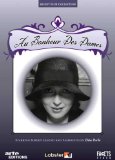| Reviews & Columns |
|
Reviews DVD TV on DVD Blu-ray 4K UHD International DVDs In Theaters Reviews by Studio Video Games Features Collector Series DVDs Easter Egg Database Interviews DVD Talk Radio Feature Articles Columns Anime Talk DVD Savant Horror DVDs The M.O.D. Squad Art House HD Talk Silent DVD
|
DVD Talk Forum |
|
|
| Resources |
|
DVD Price Search Customer Service #'s RCE Info Links |
|
Columns
|
|
|
Au Bonheur des Dames
THE MOVIE:
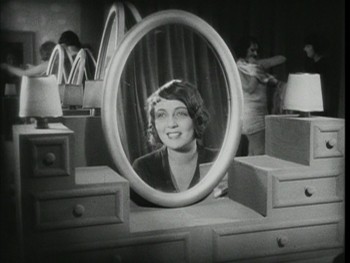
Julien Duvivier's 1930 silent film Au Bonheur des Dames is a visual delight. It's a winning example of the regular cinematic innovation undertaken by silent film directors, using real sets, evocative compositions, and even some pioneering matte work to create a complete and utterly stunning world. Based on an Emile Zola novel, Duvivier and screenwriter Noël Renard update the story of the country girl seduced by the glitz of big city shopping to the 1920s, making an effective commentary on capitalist greed and the perils of progress at any cost. Though the movie famously flinches in the final scenes, doing an astonishing about face that would make even the most money-grubbing of Hollywood execs blush, Au Bonheur des Dames manages to retain its achievement even as it loses its determination.
Up and coming German actress Dita Parlo takes the lead in Au Bonheur. The future star of Grand Illusion and L'Atalante plays Denise, a girl who has come to Paris following the death of her father. Unfortunately, some delay in her arrival means that the invitation her uncle extended is no longer as viable as it once was. The megamart department store, Au Bonheur des Dames (translated as "Ladies Paradise"), that has moved in across the street is squeezing out the man's small textiles business. Distraught and determined to pull her weight, Denise crosses the road to join the staff at the gargantuan store, getting hired on as a live model. The pool of girls is a catty bunch, and one of them, Clara (Ginette Maddie), takes an immediate dislike to the new "mannequin" when she chastises Clara for flirting with her cousin's fiancé (Fabien Haziza). Denise's curves and her lack of cynicism also capture more than one man's eye, and both the department manager and Octave Mouret (Pierre de Guingand), the store's owner, take a fancy to the innocent lamb amongst the wolves. Naturally, given how the story is rooted in melodrama, Denise spends most of the picture not knowing Mouret is anyone but a regular joe, even unwittingly badmouthing the man to his face. Still, he keeps the charade going.
Mouret's motivation and desire to conquer the entire merchant's district where Au Bonheur rests is the engine that drives the movie. Based by Zola on a real tycoon, Mouret is a scary predictor of the kind of dominating business tactics that led to many a boom and bust in recent decades. Determined to undersell his competitors until they can no longer compete, Mouret is one of those wheelers and dealers who finagles money out of one investor to pay for other investments, sidling up to a wealthy woman (Germaine Rouer) to use her business connections to finance expansion. Along with Clara, this woman will be Denise's biggest enemy, her jealous machinations shifting gears to crush the girl's romantic interests and her family's livelihood. Clara's hold on the weak-willed husband-to-be will end up being disastrous to Denise's poor-of-health cousin (Nadia Sibirskaïa) and Mouret's new investors will snatch up her uncle's loans to force him into default.
Duvivier shot the interior department store scenes in a real store, an art deco palace that looks like a Busby Berkley stage set. Populating the sales floor with counter-to-counter people, he moves through the hustle and bustle of the crowds and into the back rooms where the merchandise is prepared and the cash counted. Shot by a quartet of cameraman, Au Bonheur des Dames is lively and dynamic, paced to the energy of an active business day. Unambiguous comparisons are made between the store and religion, with the monstrosity regularly being referred to as a modern temple. Like some demented messiah, Mouret intends to bring the women of Paris under his thrall, and the glitz and glamour of his shop is intentionally overwhelming and hypnotic. If it weren't a real set, one could easily accuse the director of going over the top with it.
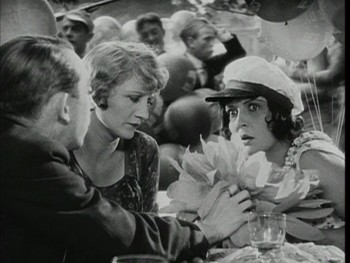
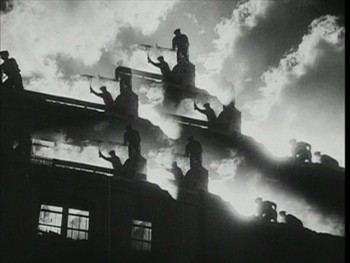
Duvivier is careful not to let the size of this grand location overwhelm him, however, he remembers where the details are. Close-ups of the actors, and especially Parlo, are usually long and meaningful, emphasizing that it's the human element that makes the spectacle possible. So, too, does he remember that it's the work force that keeps these machines running, and he shows the busy hands going about their tasks. Montages of the workers who are demolishing the rest of the neighborhood to make way for the growth of Au Bonheur des Dames are stunning odes to the men who swing the hammers. Often backlit so that the laborers appear as silhouettes, they call to mind communist propaganda, and the ironic juxtaposition of these forward-moving work crews to the crumbling world of Denise's family causes us to wonder who will be the real victim here. Are the men who are clearing out the small businesses for Mouret really only enslaving themselves?
The acting in Au Bonheur des Dames is often understated and surprisingly free of the mannerisms that characterize most people's impressions of silent films. Dita Parlo's wide eyes make her a natural choice for Denise, but Ginette Maddie as Clara and the man who plays the co-worker who has a crush on Denise are even more naturalistic than she is. Their pantomime isn't at all theatrical, and a confrontation between them in the store cafeteria is a particular high point in the movie.
Outside of the more obvious comparisons between consumerism and religion, most of the writing in Au Bonheur des Dames is equally understated. Sure, there are moments of high melodrama, but Duvivier and Renard keep a tight rein on them, knowing the correct pitch to make sure they are effective and properly balanced against the rest of the picture. You would think they would have better instincts than to stick to Zola's original ending then, but alas, they do not. After the climax where the dual ruin of his business and his daughter's engagement drive the uncle to desperate measures, both the original novel and the screenplay tack on an epilogue where the capitalist critique swings in the other direction. In the final moments, we are told that progress is good, it's only made to look bad the foibles of men that get in its way. The obnoxious justification for all that has occurred is that Mouret and Denise weren't being true to themselves, they shouldn't have denied their fates as lovers. Don't blame the department store for grinding men under its wheels (almost literally, too!), blame the men for not knowing their place enough to get out of the way.
I'm sure it's a justifiable ending in some eyes. I can easily imagine some NeoCon fatcat declaring Au Bonheur des Dames his favorite movie (once he gets past the fact it's in French), but the main narrative of the film is so effective, any explanations for why the change of heart in the last few minutes are going to seem tenuous at best. It makes for one of those baffling endings, not unlike the forced coda on Murnau's The Last Laugh, that will make cinema fans constantly lament what might have been. Seriously, if there was ever a time where a filmmaker could have gotten away with deviating radically from the source material, it was this one. Still, a flawed classic is still a classic, and despite the wrong turn, Au Bonheur des Dames deserves to be considered as such.
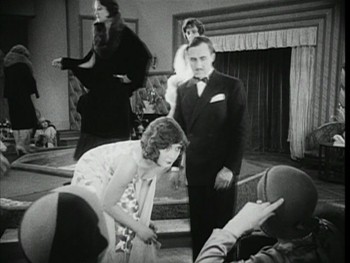
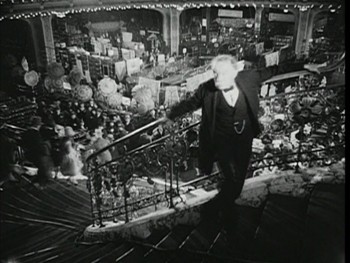
THE DVD
Video:
This DVD transfer for Au Bonheur Des Dames is most excellent. The black-and-white, full-frame image has been cleaned up and restored by the Cinenamatheque Francais, and it appears to have been struck from well-preserved original elements. Sure, there is occasional haziness around the edges, and there are also a handful of scenes with scratches or other damage, but these are all brief and never to any great extent, not for a movie this old and with such a checkered history (the video intro notes that there was actually a version with sound that is, at this time, lost). The dark and light contrast in the image is super, too.
Sound:
There is a new score for the movie by Gabriel Thibeaudieu, performed by the Octuor de France. It's a fairly good job, though maybe overbearing at times. I'd maybe have preferred the music to be pulled back in some of the more vivid montages, where the movement on screen speaks for itself. I am also not as keen on the parts where operatic singing is employed, nor the single instance of a spoken line of dialogue synched up to match Dita Parlo's lip movements. It's too distracting, too attention grabbing. Still, this is largely personal preference, and the new score is not awful by any stretch of the imagination. The recording and presentation of it is very good.
French intertitles retain the original language of the film, and both English and German subtitles are available. The packaging also promises the intertitles in the other languages, but I think that is a misprint.
Extras:
Serge Bromberg, owner of Lobster Films, has recorded a video introduction (just over 5 minutes), that explains some of the history behind Au Bonheur Des Dames, including production details, the various versions of the movie, and some of Bromberg's impressions of the movie. Surprisingly, the better feature for dissecting the movie and the influences that may have come to bear in the creation of it is the short piece (just under 10 minutes) about the recording of the music, in which Gabriel Thibeaudieu shares his analysis of Duvivier's aesthetic and how it lead him to make some of the choices he did when composing the soundtrack. It's a very insightful piece.
A short documentary featurette from the same period as Au Bonheur Des Dames is included. Entitled Le Ventre d'un Magazin, this 11-minute silent film promises to take us into the machine that powered a department store of the era, but really focuses on the kitchen that worked tirelessly to feed the staff. Still, it's a fitting companion for the main feature.
As with previous releases from this imprint, there is a gathering of clips, nearly 13 minutes in length, from other films included in the Arte "Silent Era" line alongside Poil de Carotte and Au Bonheur des Dames. Though, I am not exactly sure how much of that collection is available in the states; this is a region 0, NTSC DVD.
FINAL THOUGHTS:
Julien Duvivier's 1930 silent adaptation of an Emile Zola novel is a breathtaking visual tour de force. Au Bonheur des Dames is the story of a country girl, played by the revered actress Dita Parlo, who goes to Paris and gets work as a model at the lavish department store that, ironically, is the source of her own family's impending financial ruin. With a melodramatic romance plot woven through a scintillating social critique portraying about the consequences of cherishing progress over all else, Au Bonheur des Dames is an effective parable of human folly. Told with style and energy, it has an impressive mis-en-scene that uses real locations to create a larger-than-life sensation. Sure, it has one of those classically disputed endings that will forever mar what could have otherwise been a near-perfect film, but even accepting that, Au Bonheur des Dames is still Highly Recommended.
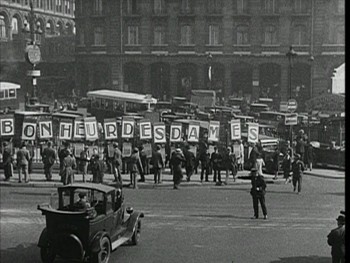
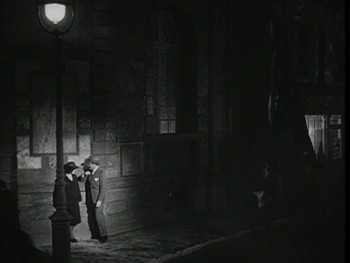
Jamie S. Rich is a novelist and comic book writer. He is best known for his collaborations with Joelle Jones, including the hardboiled crime comic book You Have Killed Me, the challenging romance 12 Reasons Why I Love Her, and the 2007 prose novel Have You Seen the Horizon Lately?, for which Jones did the cover. All three were published by Oni Press. His most recent projects include the futuristic romance A Boy and a Girl with Natalie Nourigat; Archer Coe and the Thousand Natural Shocks, a loopy crime tale drawn by Dan Christensen; and the horror miniseries Madame Frankenstein, a collaboration with Megan Levens. Follow Rich's blog at Confessions123.com.
|
| Popular Reviews |
| Sponsored Links |
|
|
| Sponsored Links |
|
|
| Release List | Reviews | Shop | Newsletter | Forum | DVD Giveaways | Blu-Ray | Advertise |
|
Copyright 2024 DVDTalk.com All Rights Reserved. Legal Info, Privacy Policy, Terms of Use,
Manage Preferences,
Your Privacy Choices | |||||||









